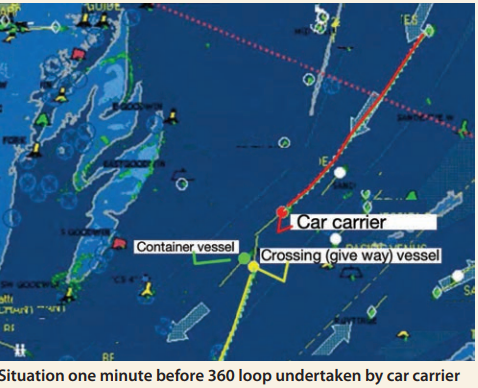The Nautical Institute presents an incident where, in darkness and good visibility, a car carrier under pilotage entered the south-west traffic lane of a busy traffic separation scheme (TSS) at a speed of 17 knots.
The incident
There was a container ship 1.7 nautical miles (nm) ahead on a similar course and speed. At 02:49 a target was acquired by radar at a range of 5nm. Four minutes later, the ARPA alarm sounded, warning the bridge team on the car carrier that this target was a danger. It was now 2.89nm away, with a CPA of 0.21nm in 5.12 minutes. The pilot of the car carrier attempted to call the target vessel on VHF to no avail. Hand steering was soon engaged and, even though they were the stand-on vessel, 10 degrees of starboard helm was ordered.
When the vessel had turned about 30 degrees to starboard, the wheel was returned to amidships. The pilot then called Vessel Traffic Services (VTS) to inquire about the intentions of the target vessel. During the next two minutes there was an exchange on VHF radio between VTS and the two vessels, but the give way vessel was not clearly communicating their intention to alter course. Soon, the pilot on the car carrier ordered the helm hard-a-starboard. The give way vessel was now 1.16nm away, with a CPA of 0.13nm in 2.9 minutes. The pilot on the car carrier informed the give way vessel on VHF radio: ‘You are the give way vessel. Now I am going hard-a-starboard sir. Hard-a-starboard’. The car carrier completed a 360 degree turn to starboard. As a result of this evasive action, the CPA with the other vessel was now 1nm.
The crossing (give way) vessel had originally planned to cross the TSS at near 90 degrees to the direction of the traffic flow but they had not yet altered course due to traffic. They entered the south-west traffic lane against the traffic flow at a shallow angle. This was far from the 90 degrees as planned or as required by the Colregs. The Master instructed the OOW to carry out a trial manoeuvre on the ARPA radar to accurately assess the situation before committing to an alteration of course. The OOW followed the instructions, but did not enter a time delay.
The CPA information displayed at the bottom right hand side of the screen indicated the container vessel ahead of the car carrier had a CPA of 0.87nm in 13.5 minutes. The Master and OOW understood this to be the results of the trial manoeuvre – where it was in fact real-time data. In line with the company’s recommended practice, the Master intended to alter course to port using a slow rate of turn to achieve a 3nm radius. The Master estimated that, by the time own vessel had completed the turn to port, the CPA of the container vessel would have reduced significantly. Accordingly, the OOW was told to initially adjust the course to pass close astern of the container vessel, and continue the alteration to port to pass ahead of the car carrier.
The investigation found, among other things, that in conducting the ‘trial manoeuvre’ without a time delay, and evidently mistaking the real time CPA data at the bottom right hand corner of the radar display for the CPA following the intended alteration, the information on which the Master based his decision to adjust course to pass between container vessel and the car carrier was inaccurate. It also demonstrated that neither the Master nor the OOW were familiar with the ‘trial manoeuvre’ function. Also, the slow alteration to port of give way vessel during the crossing of the south-west traffic lane was confusing, and the intentions of the bridge team were not readily apparent to other vessels.

Lessons learned
- Always cross a TSS at as close to 90 degrees as possible. This allows for unambiguous identification of your intentions.
- Being in a TSS does not give you an automatic right-of-way. In this case, the car carrier in the TSS had the right-of-way. However, had the crossing vessel been coming from the other side of the TSS the car carrier would have been the give way vessel.
- The golden rule for the give way vessel when risk of collision exists: ‘take early and substantial action to keep well clear’. Making small, incremental course changes in the hopes of increasing CPA will only add uncertainty and danger to the situation.






























































